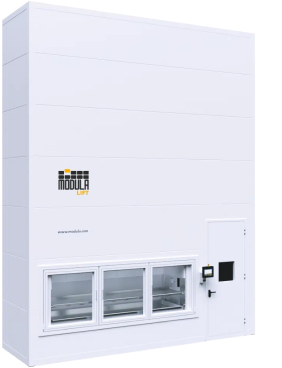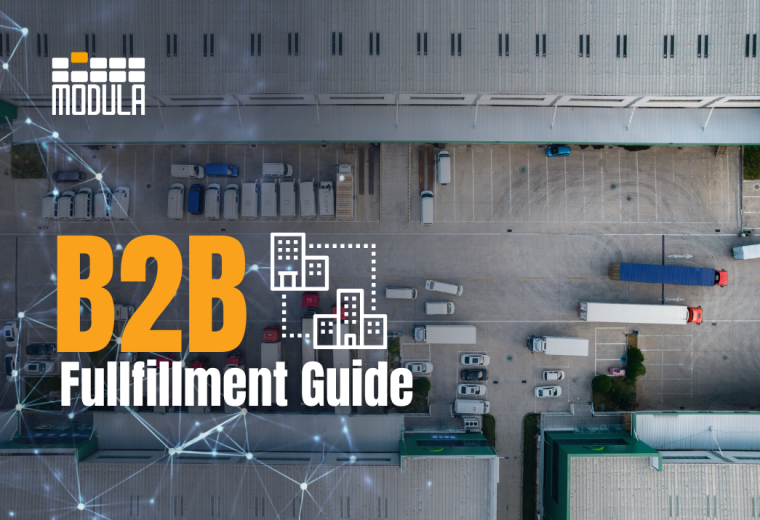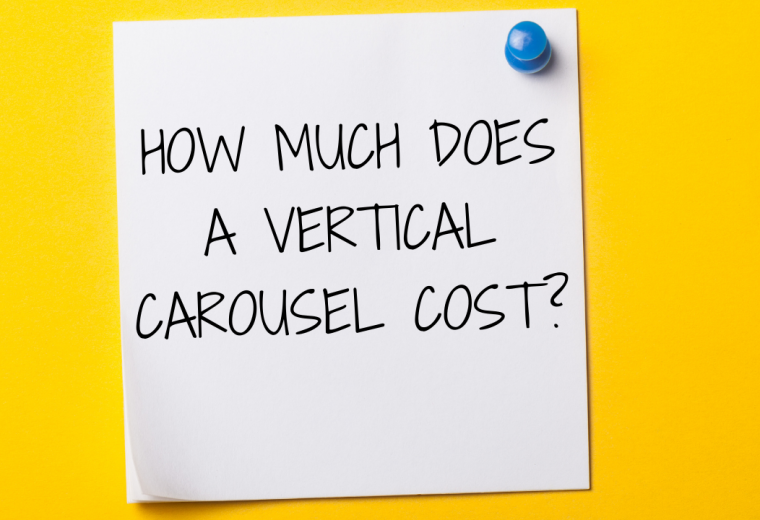A Guide To Vertical Carousel Shelves [Capabilities + Alternatives]
Vertical carousel shelves are automated storage systems that feature a series of carriers that rotate on a vertical track to deliver stored items directly to an operator.
They’re designed to convert unused ceiling height into productive storage space, condensing a large volume of inventory into a compact footprint.
But as with any automation technology, effectiveness depends on context. While carousel shelves can offer clear benefits, they also come with limitations that may affect performance in certain environments. In this guide, we’ll explore their core capabilities, where they’re most useful, and how they compare with vertical lift modules (VLMs), a more flexible alternative for many warehouse operations.
What Are Vertical Carousel Shelves?
A Vertical carousel shelf, also known as shelving carousel or vertical carousel storage system, is an automated storage unit designed to optimize vertical space. It consists of a series of carriers, such as trays, bins, or shelves, mounted on a motorized chain track that rotates vertically inside an enclosed metal frame.
How Do Vertical Carousel Storage Systems Work?
The operating principle of a vertical carousel shelf is best compared to a Ferris wheel.
When an item is requested, the system rotates the carriers vertically and delivers the correct tray to an access window at a comfortable working height. Here’s how the process works:
- Item Selection: An operator uses a simple keypad or computer interface to request a specific item or shelf location.
- Automatic Rotation: The motor-driven track rotates all the carriers in a vertical loop, taking the shortest path to the designated location.
- Inventory Presentation: The correct carrier stops at a waist-level access window, presenting the inventory to the operator for picking or replenishment.
This “goods-to-person” method eliminates the time-consuming and unproductive walking and searching associated with traditional static shelving.
Benefits of Vertical Carousel Shelves
Vertical carousel shelves can help streamline storage in facilities with space constraints or repetitive picking tasks. Here are some of the most common benefits:
Space Optimization
By using overhead space, carousel shelves can reduce the floor area needed for inventory storage—often by 60% or more compared to static shelving. This can free up space for other operational functions or allow more inventory to be stored in the same footprint.
Improved Picking Productivity
Items are automatically delivered to an access point, eliminating the need to walk through aisles or search for SKUs. This “goods-to-person” approach helps reduce retrieval time and enables a single operator to manage a larger volume of inventory.
Enhanced Ergonomics and Safety
All items are presented at a consistent, waist-level height, reducing strain from bending, lifting, or climbing. This setup supports a safer and more ergonomic working environment, particularly in operations with repetitive picking tasks.
Common Applications for Shelving Carousels
Vertical carousel shelves are typically well suited for environments where items are relatively uniform in size and weight. Common use cases include:
- Medical supply and pharmacy inventory
- Storage of small parts in manufacturing and assembly
- Tool and die management in production areas
- Office supplies, documents, or file archive storage
- Distribution of electronic components
Limitations to Consider with Vertical Carousel Shelves
While vertical carousel shelves can provide space savings and ergonomic improvements, they also come with some inherent limitations that may affect suitability depending on your application:
Unit Depth Constraints
While vertical carousel shelves are available in different sizes in terms of height and width, most carousel shelves have a standard unit depth of around 5 feet.
This depth allowance means that they are ideal for storing more compact items or small parts.
For bulkier goods, this depth may not be sufficient, and alternative solutions like static shelving or other vertical systems may be more appropriate.
Fixed Tray Height Configuration
All trays in a carousel share the same height, which is set during installation. To accommodate the tallest item in your inventory, you may end up wasting vertical space in carriers holding smaller items.
This reduces overall storage density and limits flexibility as inventory changes.
Limited Load Capacity and Weight Balance Sensitivity
These systems are best suited for lightweight or evenly distributed items.
When storing heavy or unbalanced loads, the rotating mechanism can experience vibration or uneven wear, potentially impacting system performance and longevity.
Handling Fragile Items
Since the system rotates all carriers during operation, it may not be ideal for storing fragile inventory. Movement during each cycle increases the risk of jostling or impact, especially for breakable items like glass or delicate components.
Sequential Tray Access
The carousel rotates trays in a fixed sequence to reach the desired one. This can delay access to items located farther in the loop, impacting picking speed compared to systems that dynamically retrieve any tray at any time (e.g., vertical lift modules).
Full Inventory Exposure During Rotation
As trays rotate past the access window, other items may be temporarily visible, even if not needed. This can raise security concerns when storing high-value, sensitive, or restricted inventory.
Basic Security Options
Some carousel systems include operator logins or locking mechanisms, but in most designs, the nature of the rotation makes it more difficult to limit exposure to specific trays. More advanced access control is typically found in other types of automated storage systems.
A More Flexible Alternative: The Vertical Lift Module (VLM)
When you need more flexibility, load capacity, or security, vertical lift modules (VLMs) offer a strong alternative to vertical carousel shelves. VLMs are automated storage and retrieval systems that automatically deliver trays directly to the operator based on the goods-to-person principle. They use a vertical extractor that travels between two tray columns, retrieving the required tray and presenting it at an ergonomic access window.
Compared to carousel shelves, VLMs offer greater flexibility, capacity, and control, making them well-suited for a wider range of inventory profiles.
Maximize Storage Capacity
Vertical lift modules automatically detect the height of stored items and place each tray in the most efficient vertical position, optimizing internal space.
In comparison, vertical carousel shelves have a more rigid configuration, with fixed carrier heights that must accommodate the tallest item in the system. This often results in unused vertical space in other trays.
Flexible Storage for Mixed Inventory
VLMs can store items of various shapes and sizes without the need to standardize tray height across the unit. The system adapts dynamically as inventory changes, improving storage density over time.
Carousel shelves, by contrast, lack this flexibility due to their fixed structure.
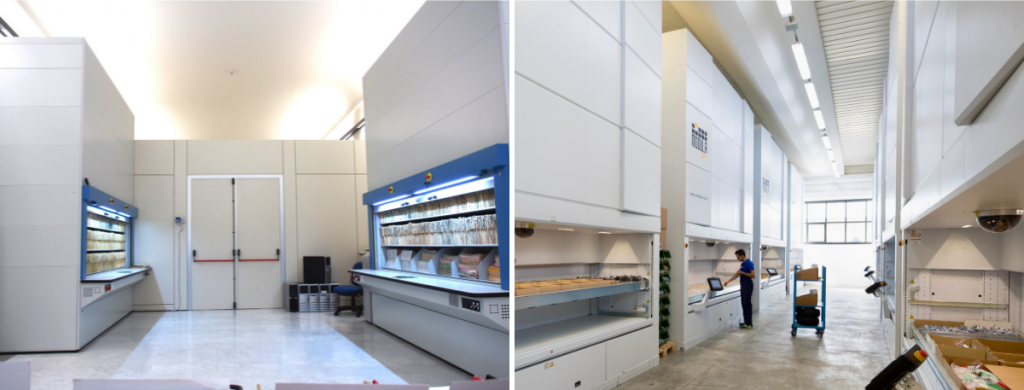
Offer A Safe Working Environment
VLMs present trays at an ergonomic height, reducing physical strain and the risk of overexertion injuries for warehouse operators.
While carousel shelves also bring items to a fixed access point, operators may still need to reach, bend, or adjust posture to retrieve certain goods, especially if they’re not centered or if the tray depth is significant.
Provide Better Payload Storage Capacity
VLMs are structurally designed to handle heavier inventory. For example, Modula’s trays can support up to 2,200 pounds each.
In Carousel shelves, all carriers move together, and imbalanced or heavy loads can lead to vibration, motor strain, and uneven wear over time.
Improve System Stability and Reliability
Because VLMs retrieve only one tray at a time, there’s no need to rotate the entire inventory with each transaction. This design reduces mechanical stress, increases stability, and helps extend the life of key components.
Boost Inventory Security
VLMs offer better control over inventory exposure because they present only one tray at a time. This approach minimizes access to other items and helps reduce risks of theft or mishandling. Access control features, such as user authentication, further enhance security.
In contrast, carousel shelves expose multiple items during each cycle as all trays pass by the access window, even when an operator isn’t accessing them.
| FEATURE | VERTICAL CAROUSEL SHELVES | VERTICAL LIFT MODULES (VLMs) |
| Storage Density | Fixed tray height limits flexibility and may waste vertical space | Tray height is dynamically adjusted for maximum space optimization |
| Inventory Size Compatibility | Best suited for small, uniform items | Fast, optimized tray delivery via the shortest path |
| Ergonomics & Operator Safety | Items presented at fixed access point; may require bending or reaching | Trays delivered at ergonomic height, reducing strain and injury risk |
| Load Capacity | Limited weight per tray; imbalance can affect system performance | High payload capacity (up to 2,200 lbs per tray); stable under heavy loads |
| Picking Speed | Trays rotate sequentially; speed depends on item position | Only one tray is exposed; access can be restricted by user or role |
| System Flexibility | Configuration is static once installed | Adaptable to inventory changes without reconfiguration |
| Security & Access Control | All trays rotate past access window; limited access control | Only one tray exposed; access can be restricted by user or role |
| Ideal Use Cases | Light parts, documents, tools, medical/pharma inventory | High SKU variability, heavy items, sensitive or high-value inventory |
If your needs a more flexible solution, Modula offers a full range of vertical lift modules designed to meet different operational requirements.
Vertical Lift Modules at Modula [A Shelving Carousel Alternative]
As a leading provider of automated storage solutions and warehouse management systems, Modula delivers top-notch warehouse technology to enhance productivity and efficiency throughout your organization.
Our automated solutions include:
Modula Vertical Lift Modules
Our VLMs make the most of your existing warehouse space, utilizing available ceiling height to increase storage capacity and improve efficiency.
We offer two types of VLMs:
- Modula Lift: Ideal for storing industrial components and spare parts, the Modula Lift is versatile and available in various dimensions and sizes to suit diverse inventory needs
- Modula Slim: Engineered for facilities with limited floor space, the Modula Slim occupies a minimal footprint of just 32.29 square feet. It is the perfect choice for maximizing storage in tight spaces
- Modula Next: A cutting-edge automated storage and retrieval system that merges the space optimization of vertical lift modules (VLMs) with the precision and control typically found in industrial vending technology
- Modula Pallet: A breakthrough warehouse solution built to safely manage euro pallets (1,200 mm x 800 mm) directly from floor level, removing the need for forklifts and streamlining material handling
- Modula Flexibox: With the capacity to handle up to 180 bins per hour, Modula Flexibox minimizes unnecessary movements, maximizes vertical storage and streamlines overall warehouse operations

Save Space by Going Vertical with Modula VLMs.
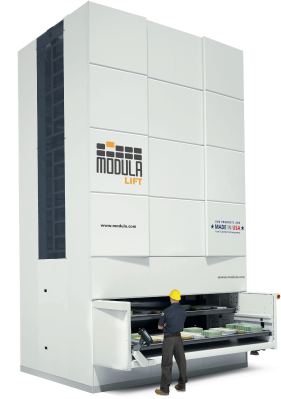
Modula Clean Room
Modula Clean Room is a VLM built to store your inventory in clean room conditions.
It is particularly suitable for the pharmaceutical and food and beverage industries, where protecting parts from contaminants like dust and debris is essential.
This VLM complies with Class 7 and 8 requirements and meets ISO 14644 standards, serving as a key tool for warehouses prioritizing cleanliness and contamination control.
Key Features – Modula Clean Room:
- Adhere to ISO 14644-1 standards
- Keep your environment free of dust and dirt
- Achieve clean room classifications from 6 to 8
- Minimize contamination risks from germs and debris
- Integrate cutting-edge technology in all Modula Lift modules
Modula Climate Control
Modula Climate Control is a VLM designed to maintain humidity and temperature in your warehouse, protecting your inventory from environmental and temperature changes.
This specialized VLM regulates air circulation, humidity and temperature in its enclosed space, providing secure storage for sensitive items, such as medical devices and electronic components.
Modula Climate Control is insulated with polyurethane foam panels that cover the entire unit, effectively protecting inventory. Warehouse operators can safely access any section of the unit through a unique panel with independently opening windows, ensuring convenience and ease of use.
Key Features – Modula Climate Control:
- Control temperatures ranging from from +2°C to +40°C (+35 °F to +104°F)
- Maintain humidity levels of 5% or more
- Utilize advanced technology in all Modula Lift modules
Wrapping Up: The Right Choice for Your Operation
Vertical carousel shelves can be an efficient solution for managing small, uniform items in environments with limited floor space. They help improve ergonomics, reduce retrieval time, and optimize vertical storage.
However, when greater flexibility, load capacity, or security is needed, vertical lift modules provide a more adaptable option. With dynamic tray height adjustment, high payload capabilities, and improved control over access and inventory exposure, VLMs are well-suited for more complex or fast-changing warehouse environments.
Choosing the right system depends on your specific layout, item types, and operational goals.
If you’re evaluating your options, Modula offers a range of solutions, including Lift, Slim, Clean Room, and Climate Control models, to help optimize your space and improve efficiency.
At Modula, we offer automated warehouse storage solutions designed to optimize warehouse space, boost efficiency and meet changing consumer demands.
If you’re not sure which solutions meet your needs, speak to our material handling specialists to find the best storage solution for your facility. We’ll perform an in-depth assessment of your warehouse so you can invest in the unit that perfectly suits your needs.

